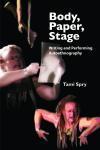Irene Ziegler's Blog - Posts Tagged "autoethnograpy"
Lady Aston's BarnStone Salon: Body, Paper, Stage, by Tami Spry
(This series shares the projects that each of seven artists brought to "Lady Aston's BarnStone Salon," held in early February at my home in Charles City, VA. The first post of the series was posted Feb. 7.)
You should go to Facebook and friend Tami Spry right now, not just because she is the coolest teacher at St. Cloud State University, or has amazing long, blond dreds,
 or is so smart you can see her brain right through her head (eww),
or is so smart you can see her brain right through her head (eww),
 but also because she lives and teaches in a castle in England for part of the academic year, and if she likes you, might invite you to visit. (But you'll have to take a number.)
but also because she lives and teaches in a castle in England for part of the academic year, and if she likes you, might invite you to visit. (But you'll have to take a number.)
 She also has a book coming out in May from Left Coast Press titled, Body, Paper, Stage: Writing and Performing Autoethnography. At Lady Aston's BarnStone Salon, she told us about it.
She also has a book coming out in May from Left Coast Press titled, Body, Paper, Stage: Writing and Performing Autoethnography. At Lady Aston's BarnStone Salon, she told us about it.

(Borrowing liberally from wikipedia now,) Autoethnography is a form of autobiographical personal narrative that explores the writer's experience of life as situated in culture. In other words, in addition to describing and looking critically at one's own experience, an autoethnography is also a cultural accounting.
Another way of putting it: autoethnography is a story that re-enacts an experience by which people find meaning and through that meaning are able to be okay with that experience. Using her own story to illustrate, Tami told us an upsetting story:
Over thirty years ago, (when we knew her when), Tami was on her way to a party, dressed to the nines and loving the way she looked. She described feeling empowered by her red high heels, big hair and carefully applied make-up. As she walked over a bridge, she saw a man at the other end. A warning bell went off, but she silenced it. After all, she had as much right as anyone to be walking alone in summer's perfect twilight. With her head high, she passed the man, only to be attacked from behind, pulled down the bank, and sexually assaulted. That horrible experience became the inspiration for her own authoethnography.
BUT, Tami told us, the purpose of autoethnography is not to indulge emotions, but ask questions. She tells students that the stage is not a doctor's office, and while it's important to reach an emotional catharsis, that important work is done in private. Sharing your story is not about "emotional vomit," but critical thinking. Over time, when one looks back at the experience, perhaps one discovers that the treatment of rape victims by police and the court system was abysmal at best, and required reform at a most basic level. Or perhaps the experience tore the lid off of a Pandora's box of difficult questions about the way we raise our sons. Or, one may find that through this hardship she became a stronger, more independent person, or found the strength to help others battle their post-traumatic stress. With these realizations, the person has actually made sense of, and has become fine with the tragic experience that occurred. And through this, autoethnography is performed.
In her book, Tami intertwines three necessary elements comprising the process. First one must understand the body – navigating concepts of self, culture, language, class, race, gender, and physicality. The second task is to put that body on the page, assigning words for that body's sociocultural experiences. Finally, this merger of body and paper is lifted up to the stage, crafting a persona as a method of personal inquiry. These three stages are simultaneous and interdependent, and only in cultivating all three does performance autoethnography begin to take shape.
Remember Mo from the last post? Who was afraid she might be experiencing debilitating memory function? She was extremely grateful to learn about this process, seeing in it, perhaps, a way to construct her own autoethnography.
And that's what happens at Lady Aston's BarnStone Salon. Share your work, change a life.
Or share your work, have 6 old friends invite themselves to stay in your castle.

Dr. Tami Spry teaches courses in performance studies and communication theory.
She performs her autobiographical and autoethnographic work around the country, focusing on issues of gender violence, mental illness, race relationships, shamanic healing, and loss.
Tami is currently working on a book, Paper and Skin: Writing and Performing the Autoethnographic Life. Her publications appear in Text and Performance Quarterly, Qualitative Inquiry, and Women and Language as well as chapters in various anthologies, most recently in Voices Made Flesh: Women and Autobiography
In 2007, Dr. Spry was invited to Fitzwilliam College at Cambridge University in England to present research on performative autoethnography, and taught in Alnwick, England. She has also done ethnographic work with Mapuche and Peruvian shaman on the performative dimensions of healing rituals.
In her spare time, she is the Director of Players Performance Group, and maintains a family on the banks of the Rum River in Milaca, MN.
You should go to Facebook and friend Tami Spry right now, not just because she is the coolest teacher at St. Cloud State University, or has amazing long, blond dreds,
 or is so smart you can see her brain right through her head (eww),
or is so smart you can see her brain right through her head (eww),
 but also because she lives and teaches in a castle in England for part of the academic year, and if she likes you, might invite you to visit. (But you'll have to take a number.)
but also because she lives and teaches in a castle in England for part of the academic year, and if she likes you, might invite you to visit. (But you'll have to take a number.) She also has a book coming out in May from Left Coast Press titled, Body, Paper, Stage: Writing and Performing Autoethnography. At Lady Aston's BarnStone Salon, she told us about it.
She also has a book coming out in May from Left Coast Press titled, Body, Paper, Stage: Writing and Performing Autoethnography. At Lady Aston's BarnStone Salon, she told us about it.
(Borrowing liberally from wikipedia now,) Autoethnography is a form of autobiographical personal narrative that explores the writer's experience of life as situated in culture. In other words, in addition to describing and looking critically at one's own experience, an autoethnography is also a cultural accounting.
Another way of putting it: autoethnography is a story that re-enacts an experience by which people find meaning and through that meaning are able to be okay with that experience. Using her own story to illustrate, Tami told us an upsetting story:
Over thirty years ago, (when we knew her when), Tami was on her way to a party, dressed to the nines and loving the way she looked. She described feeling empowered by her red high heels, big hair and carefully applied make-up. As she walked over a bridge, she saw a man at the other end. A warning bell went off, but she silenced it. After all, she had as much right as anyone to be walking alone in summer's perfect twilight. With her head high, she passed the man, only to be attacked from behind, pulled down the bank, and sexually assaulted. That horrible experience became the inspiration for her own authoethnography.
BUT, Tami told us, the purpose of autoethnography is not to indulge emotions, but ask questions. She tells students that the stage is not a doctor's office, and while it's important to reach an emotional catharsis, that important work is done in private. Sharing your story is not about "emotional vomit," but critical thinking. Over time, when one looks back at the experience, perhaps one discovers that the treatment of rape victims by police and the court system was abysmal at best, and required reform at a most basic level. Or perhaps the experience tore the lid off of a Pandora's box of difficult questions about the way we raise our sons. Or, one may find that through this hardship she became a stronger, more independent person, or found the strength to help others battle their post-traumatic stress. With these realizations, the person has actually made sense of, and has become fine with the tragic experience that occurred. And through this, autoethnography is performed.
In her book, Tami intertwines three necessary elements comprising the process. First one must understand the body – navigating concepts of self, culture, language, class, race, gender, and physicality. The second task is to put that body on the page, assigning words for that body's sociocultural experiences. Finally, this merger of body and paper is lifted up to the stage, crafting a persona as a method of personal inquiry. These three stages are simultaneous and interdependent, and only in cultivating all three does performance autoethnography begin to take shape.
Remember Mo from the last post? Who was afraid she might be experiencing debilitating memory function? She was extremely grateful to learn about this process, seeing in it, perhaps, a way to construct her own autoethnography.
And that's what happens at Lady Aston's BarnStone Salon. Share your work, change a life.
Or share your work, have 6 old friends invite themselves to stay in your castle.

Dr. Tami Spry teaches courses in performance studies and communication theory.
She performs her autobiographical and autoethnographic work around the country, focusing on issues of gender violence, mental illness, race relationships, shamanic healing, and loss.
Tami is currently working on a book, Paper and Skin: Writing and Performing the Autoethnographic Life. Her publications appear in Text and Performance Quarterly, Qualitative Inquiry, and Women and Language as well as chapters in various anthologies, most recently in Voices Made Flesh: Women and Autobiography
In 2007, Dr. Spry was invited to Fitzwilliam College at Cambridge University in England to present research on performative autoethnography, and taught in Alnwick, England. She has also done ethnographic work with Mapuche and Peruvian shaman on the performative dimensions of healing rituals.
In her spare time, she is the Director of Players Performance Group, and maintains a family on the banks of the Rum River in Milaca, MN.
Published on February 10, 2011 10:43
•
Tags:
autoethnograpy, body-paper-stage, tami-spry



